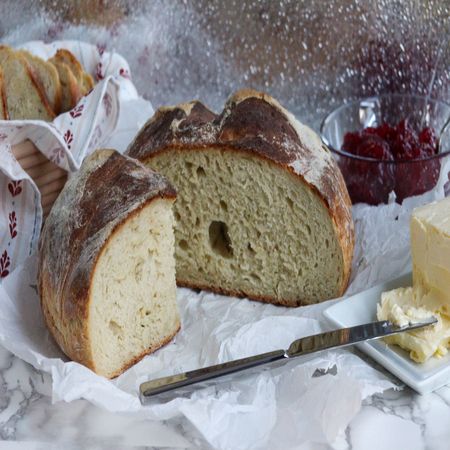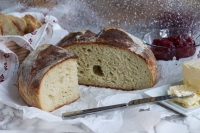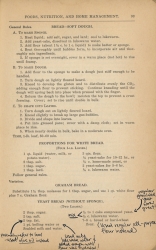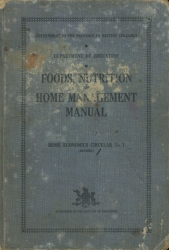
 604 465 4322
604 465 4322General Store Site 12294 Harris Road Pitt Meadows, B.C.
Click Here for Directions& Visiting Hours

Yeast Bread 1938
General Rules. Bread – Soft Dough.
A. To make sponge.
1. Heat liquid; add salt, sugar, and lard; cool to lukewarm.
2. Add yeast-cake, dissolved in lukewarm water.
3. Add flour (about 1 ½ c. to 1 c. liquid) to make batter or sponge.
4. Beat thoroughly until bubbles form, to incorporate air and thoroughly mix ingredients.
5. If sponge is set overnight, cover in a warm place (not hot) to rise until foamy.
B. To make dough.
1. Add flour to the sponge to make a dough just stiff enough to be handled.
2. Turn dough on lightly floured board.
3. Knead to develop gluten and to distribute evenly the CO2, adding enough flour to prevent sticking. Continue kneading until the dough will spring back into place when pressed with the finger.
4. Return the dough to the bowl; moisten the top to prevent a crust forming. Cover; set to rise until double in bulk.
C. To shape into loaves
1. Turn dough out on lightly floured board.
2. Knead slightly to break up large gas-bubbles.
3. Divide and shape into loaves
4. Put into greased pans; cover with a damp cloth; set in warm place to rise.
5. When nearly double in bulk, bake in a moderate oven.
TIME, 1-lb. loaf, 50-60 min.
Yeast Bread (Without Sponge). Makes 2 loaves.
2 tbsp. sugar.
2 tsp. salt.
2 tsp. fat. (Probably refers to lard - used olive oil instead)
1 pt. boiling water or scalded milk and water. (used only lukewarm water and added enough until flour was hydrated!)
1/2 to 1 cake compressed yeast. (regular granulated yeast works great!)
1/2 c. lukewarm water.
7-8 c. bread or hard-wheat flour. (Used regular all-purpose flour instead)
From the “Foods, Nutrition, and Home Management Manual” published 1938.
*****
In a large bowl, mix flour, salt, yeast, and warm water. These few simple ingredients create one of Canada’s most consumed food: bread. With its spongy interior and crunchy crust, annual bread consumption yields an average of 13.5 kg per Canadian. Even during the Great Depression, Canadians deemed bread necessary while struggling with food supply shortages. Existing throughout centuries, bread focuses on expressing traditions and the importance of honouring different cultures.
Since the early days, bread has been an essential food for Canadians, linking Canada to the agriculture and wheat industry. Bread has a long history spanning centuries, different cultures, techniques, and ingredients. In the 17th century, French settlers introduced wheat to Canada, using French techniques to bake bread. As a result, the bread industry grew, with commercial bakeries set up in major cities in the early 19th century. Modern technology advancements led to the production and distribution of bread on a larger scale. As the 20th century rolled around, bread became a staple for Canadian diets, with the type of bread consumed varying depending on the region and availability of ingredients. The discovery of the fermentation process about 4000 years ago led to the production of leavened bread appearing in Egypt, with traditional bread, as we know it, appearing around 100 years ago. Though not all bread was traditionally leavened, bannock was a staple to many diets. Bannock, unleavened, flat, and shaped into an oval, was usually made with flour, water, and fat or lard. It was then baked in the oven, pan-fried, or deep-fried. It is believed that Scottish fur traders introduced bannock to Indigenous people during the 18th and 19th centuries. Scottish bannock was often made from oatmeal or barley, while Indigenous people used corn flour or flour from ground-up plant bulbs. Variations of bannock depended on the region and the different types of flour used. As tasty and fulfilling as it can be, bannock serves as a reminder of colonialism’s impact on the Indigenous people. Many were moved off their lands and territories and placed on reserves, unable to live and hunt off the land. With very few rations supplied by the Canadian government, bannock became a necessity to prevent starvation. Indigenous people continue to sustain deep wounds from European influences experienced during Canada’s colonial history. Still, learning and expressing the difference in cultures through food, like bannock, can extend an olive branch towards thoughtful discussions and empowerment.
In 1938 bread remained a necessity and staple in Canadian homes despite the economic downfall within the country. The Great Depression brought uncertainty and widespread losses. Canada was severely affected, with millions left unemployed, homeless, and starving. The 1930s was also commonly referred to as the Dirty Thirties due to a brutal drought in the Prairies. This led to job losses, social welfare, populist political movements, and the demand for the government to step up from the laissez-faire attitude. The changes were dramatic in Canada, with one in five Canadians relying on government relief. This cycle continued until 1939 when WWII started. Bread was essential to the Canadian war effort, producing rations sent to troops. This led to the development of fortified bread containing vitamins and minerals to ensure proper nutritional values. In the post-war years, bread continued to evolve in Canada, with artisanal bakeries producing bread such as sourdough and whole grain, all of which are still available today.
Pitt Meadows was also a community affected by the Great Depression, with many families relying on relief. By 1931 the population in Pitt Meadows was about 800. The early 1930s brought more businesses to Pitt Meadows, such as the Fairfield Garage, a predecessor to Hoffmann and Son, the Consolidated Grocers was built by the Struthers family to replace the old general store, and a garage and blacksmith shop made by Ben Schlick. In December of 1930, the Municipal Hall, built in 1914, burned to the ground when a fire started in the annex. Under Reeve Charles Cook, construction began on the new municipal and recreation hall in 1931. The Women’s Institute sponsored the first library van in the same year and would later start a drive to establish permanent school libraries. With the drive having success, the Institute continued to sponsor the school libraries until 1965. May of 1937 marked the first and last May Day in Pitt Meadows, with Isabell Sharpe crowned May Queen. In 1938, the event became Pitt Meadows Sports Day and Strawberry Carnival, with Anne Anderson crowned Queen that year. The event evolved into Pitt Meadows Day in 1945. The Pitt Meadows Athletic Association was formed in 1938 with the scope of developing park and playground space, with one project being a lacrosse box and developing a team. In 1940 the team won the Provincial Intermediate Championship. All the new development in Pitt Meadows still did not ease the strain of food unavailability. Refrigerators would start making an appearance in Canadian homes. Still, a small community such as Pitt Meadows would continue with traditional food storage, especially during the Great Depression when food, which was hard to come by, was not wasted.
Despite its original roots and dire history, bread remains one of the preceding foods still available and widely consumed to this day. Bread recipes have evolved to fit modern-day expectations, passed down from generation to generation, and vary in ingredients and techniques. For many, bread is fundamental and often shared over fresh butter, a cheese plate, or a peanut butter and jelly sandwich. Whatever form it comes in, bread creates a connection between us and the past and solidifies the relationship of learning from and creating pieces of history.

Bread from 1938

Recipe for 1938 Yeast Bread

Food, Nutrition, Home management manual from 1938





